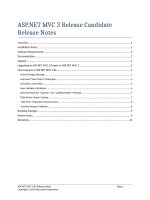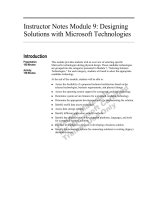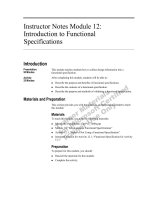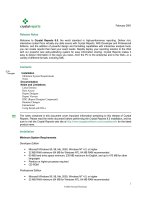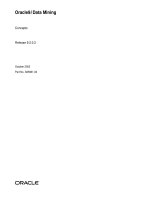Release Notes
Bạn đang xem bản rút gọn của tài liệu. Xem và tải ngay bản đầy đủ của tài liệu tại đây (297.38 KB, 8 trang )
February 2001
Release Notes
Welcome to Crystal Reports 8.5, the world standard in high-performance reporting. Deliver rich,
interactive content from virtually any data source with Crystal Reports. With Developer and Professional
Editions, and the addition of powerful design and formatting capabilities with interactive analysis tools,
you can create reports that meet your exact needs. Rapidly deploy your reporting solution to the Web
with our powerful new web-publishing system for easy information sharing. Crystal Reports makes it
easy to deliver information in the ways you need—from the PC to the enterprise and to the Web—in a
variety of different formats, including XML.
Contents
Installation
Minimum System Requirements
Notes
Documentation
Notes and Limitations
Lotus Domino
Data Access
Report Designer
Report Viewers
RDC (Report Designer Component)
Runtime Changes
International
Using thread-safe DLLs
The notes contained in this document cover important information pertaining to this release of Crystal
Reports. Please read the entire document before performing the Crystal Reports 8.5 installation, and be
sure to visit the Crystal Reports web site at for the latest
product news.
Installation
Minimum System Requirements
Developer Edition
• Microsoft Windows 95, 98, Me, 2000, Windows NT 4.0, or higher
• 32 MB RAM minimum (64 MB for Windows NT), 64 MB RAM recommended
• 60 MB hard drive space minimum; 235 MB maximum for English, and up to 470 MB for other
languages
• Pentium or higher processor required
• CD-ROM
Professional Edition
• Microsoft Windows 95, 98, Me, 2000, Windows NT 4.0, or higher
• 32 MB RAM minimum (64 MB for Windows NT), 64 MB RAM recommended
1
© 2001 Crystal Decisions
To
Navigate
• 60 MB hard drive space minimum; 174 MB maximum for English, and up to 350 MB for other
languages
• Pentium or higher processor required
• CD-ROM
Standard Edition
• Microsoft Windows 95, 98, Me, 2000, Windows NT 4.0, or higher
• 32 MB RAM minimum (64 MB for Windows NT), 64 MB RAM recommended
• 60 MB hard drive space minimum; 155 MB hard drive space maximum
• Pentium or higher processor required
• CD-ROM
Notes
- If you choose not to install to the default installation directory, do not specify a directory whose
name includes DBCS characters (such as Japanese characters), diacritical marks (è, ä, ñ, etc.),
and/or other special characters (Æ, æ, etc.).
- Because Crystal Enterprise replaces the version 8 Web Component Server, the following sample
reports have been removed from the Crystal Reports 8.5 installation:
Max # of concurrent users by day.rpt
Max # of concurrent users by week.rpt
- When installing Crystal Reports 8.5 on a machine on which both the Crystal Reports 8 Developer
Edition AND the Compiled Reports add-in are installed, it will be necessary to re-install the
Compiled Reports add-in. (The CR 8.5 install will remove the compiled reporting option.)
For complete installation instructions, refer to the “Installing Crystal Reports” chapter of the Crystal
Reports User’s Guide (included as UserGde.pdf in the /Docs directory of your product CD).
Documentation
- The printed version of the Crystal Reports 8.5 User’s Guide incorrectly identifies the database
drivers which are thread-safe. Please see the section “Using thread-safe database drivers” in this
document for the correct listing.
- The printed version of the Crystal Reports 8.5 User’s Guide does NOT list the up-to-date system
requirements in the “Installing Crystal Reports” chapter. Please refer to the ‘Installation’ section of
this document for the correct system requirements.
- Users who use a Netscape browser to view the online help will find that the text inside the Contents
area does not automatically refresh to fill the frame’s dimension when the window is resized. To
refresh the text in the Contents area, users must click the Contents button.
- Users who have received Crystal Enterprise 8 as an addition to their Crystal Reports 8.5 product are
supplied with only the Administrator’s guide in printed format. Printable versions of the Quick Start,
Installation, User’s, and Administrator’s guides (in .PDF format) can be found in the \doc directory of
the Crystal Enterprise 8 product CD.
2
© 2001 Crystal Decisions
Notes and Limitations
Lotus Domino
• If you plan on using Crystal Reports in conjunction with Lotus Domino, you may want to view the
new Lotus Domino sample reports. These documents demonstrate the ways in which Crystal
Reports enables you to increase the value of your Lotus Domino investment.
Notes:
- The Lotus domino sample applications are installed only if Lotus client software is detected on
the local machine. This holds true whether you choose the Complete installation option or select
the Lotus Data Access option explicitly during a Custom installation.
- If you follow the default installation, you will find the sample .nsf files in the C:\Notes\data
directory and the sample .rpt files in the C:\Program Files\Seagate Software\Crystal
Reports\Samples\En\Code\Lotus Domino directory.
- You can serve these reports up from within a Lotus Notes application by opening either
Crazev6.nsf or Xglobal.nsf from within Lotus Notes.
Data Access
• Accessing XML data sources
When setting up an XML data source, the location can be specified as either a path or a URL.
Please note the following:
- If file name is not specified in the path (e.g., c:\myxmlfiles), the Data Explorer will display each
XML file in the directory c:\myxmlfiles as a table.
- If file name is not specified in the URL (e.g., gatesoftware/xml_samples), the
report designer will prompt the user to specify the table name (i.e., the file name without the
".xml" extension). This will occur because the Merant XML ODBC driver is not able to enumerate
files on a URL location.
• Lotus Notes
In Crystal Reports, the new version of p2snote.dll (p3slnxx.dll in localized versions), version
8.0.100.21 and above, results in several new behaviors. Due to the changes mentioned below,
please verify all reports when first running them in Crystal Reports 8.5. (To verify a report, click
Verify Database on the Database menu). Users may be required to re-map database fields. For
information on this procedure, please see the section “Remapping altered databases” in the Crystal
Reports online help.
If your report still fails to run, open the report and click “Set Location” on the Database menu. Set the
location of each form or view in your report.
The changed behaviors are as follows:
- When reporting off a form in Lotus Notes, you may notice that the order of the report data is
different from the original sequence. This is because Crystal Reports takes advantage of “View
as index” to speed up form lookups. This may switch the sequence of the form to that of the
view.
If you report off a form in Lotus Notes, and if the form is not used by any views, then the
report data will appear in its original order. If you report off a form that is used by a view, and
if the form is the only form used by the view, then the report data will appear in the same
order as in the view—that is, the report data will be sorted according to the field that is sorted
3
© 2001 Crystal Decisions
in the view. If the view is not sorted, then there is no field for Crystal Reports to use as an
index; in such cases, the report data appears in alphabetical order.
- When reporting off a view, Crystal Reports now uses the field name instead of the column name.
- Crystal Reports now has the ability to read Numeric and DateTime data types if the view is
based on a single form. Consequently, if users open old reports and refresh the data with
p2snote.dll, then they will need to re-map the database fields. For information on this procedure,
open the Crystal Reports Online Help, type “mapping” in the Index search field, and double-click
“Remapping altered databases.”
• NotesSQL (Lotus Notes ODBC driver)
- Lotus ODBC returns errors or incorrect results when you attempt to link tables with outer joins.
NotesSQL presently supports outer joins for two tables only. In addition, within Crystal Reports,
Right Outer Joins are incorrectly treated as Left Outer Joins.
- If you are using Windows 2000 and reporting (via ODBC) off of a view containing a date field,
then browsing on that date field may cause your system to quit unexpectedly. The workaround
offered by Lotus is to set the environment variable “Temp” to a shorter path. For instance, use
C:\Temp instead of C:\Documents and Settings\UserName\Local Settings\Temp.
• Closed OLE DB providers installed with Crystal Reports 8.5
In the Windows Datalinks dialog box, users may notice the following Closed OLE DB providers,
which are installed with Crystal Reports 8.5:
- Crystal Services Closed XML ADO Provider
- Crystal Services Closed Integrator Base
These providers are “Closed” because they cannot be used by any programs other than the Crystal
programs for which they were designed. Neither provider is usable by other third-party applications
on the machine, even though both providers may appear in the Datalinks dialog box when accessed
from third-party applications.
• Maximum concurrent connections to MS SQL Server
MS SQL Server’s maximum number of concurrent connections is, by default, set to 25. However,
Microsoft offers a workaround that allows you to change this default setting. Information on how to
do this is currently available from the Microsoft Kbase web site at:
/>Note: If the MaxDBProcesses value name already exists, the new version of p2ssql.dll (p3ssqxx.dll
for localized versions) will set the maximum concurrent connections to the existing value. Otherwise,
the default value of 25 will be used.
• Informix database access
If you use the Informix native driver, p2sifmx.dll (p3sifxx.dll for localized versions), ensure that the
Informix client application is running on a single CPU machine.
• ACT! database access
When reporting off of an ACT! database, it will be necessary for users to link their database tables
manually: the ACT! database driver currently does not perform “smart linking” in the correct manner.
To download complete instructions (available in English only) on how to best link ACT! tables with
the Crystal Reports 8.5 driver, please visit the Crystal Reports web site at:
4
© 2001 Crystal Decisions
www.seagatesoftware.com/docs
Notes:
- The ACT! driver cannot report off the "Regarding" field in ACT!
- ACT! 2000 driver supports only one BLOB/MEMO field per file in each report.
- Record Manager fields or fields that are unique identifiers (for linking purposes) will appear as
alphanumeric and special character strings when included in a report:
• BDE Driver
The BDE driver has been updated for faster performance and better support of Memo fields.
Because of this update, existing reports based on the older BDE driver should be re-verified before
being run as the Memo field size has changed.
• Maximum Number of Database Tables
Crystal Reports 8.5 supports up to 2147483647 database tables at any one time. When a value
greater than 2147483647 is stored in the HKEY_Current_User\Software\Seagate
Software\Crystal Reports\FetchOptions\NtablesMax registry key, users may receive
an “Out of memory” error and/or a blank Data Explorer.
• Date Fields in Microsoft Access database
When creating a report off a Microsoft Access database with a date field in it, only dates that fall in
the range from 1753 to 9999 are supported. [Microsoft Access 2000 and Jet 4.0 support dates
ranging from the year 100 to the year 9999. However, MS Access ODBC (odbcjt32.dll) shares a
limitation with SQL Server in that only years ranging from 1753 to 9999 are supported.]
Report Designer
• Opening 8.5 reports in version 8.0
Generally, reports created in Crystal Reports 8.5 open correctly in Crystal Reports 8.0. However,
any new 8.5 features will be unavailable. For example, Report Alerts, summaries across hierarchical
groups, new pie chart features, support for XML data sources, and other new features are not
supported by version 8.0. Consequently, errors may occur when you view such reports in version 8.0
report designers, applications, or Web Component Servers.
• Options
At present, the “COUNT Number of Records First” option is available only for ODBC and SQL data
sources. This option is accessible by clicking File > Options > Reporting.
• Conditional Formatting with Formulas
Always include the Else keyword in conditional formulas. If you want to leave values unchanged
when they do not meet your specified condition, use the DefaultAttribute function in the Else
portion of your formula. If you do not include the Else portion of the statement, values that do not
meet the specified condition may not retain the format that you expect.
For instance, to increase the font size of the names of all countries other than the USA—while at the
same time leaving the font size of USA unchanged—you would use this formula:
If {Customer.Country} <> "USA" Then 15.5
Else DefaultAttribute
5
© 2001 Crystal Decisions
